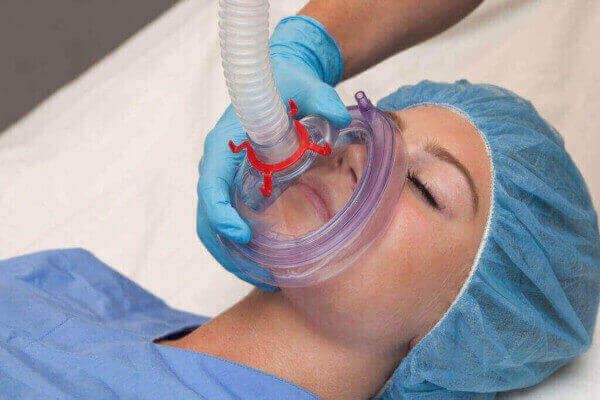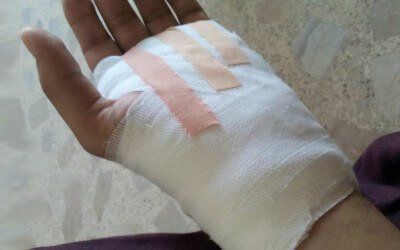How Long is Carpal Tunnel Surgery Recovery Time?
Table of Contents
- Day of surgery
- 4 Stages in carpal tunnel surgery recovery time
1. Immediate post-operative carpal tunnel surgery recovery time
2. Post-discharge (at home)
3. Within 2 weeks of discharge
4. Long-term recovery time
Carpal tunnel surgery recovery time varies from patient to patient. Typically, post-surgical pain lasts a few days. Stitches are removed in 7-10 days. In another 2-4 weeks, your hand starts to normalize again as the
scar firms up.
But this normal time course assumes there are no complications. Obviously, no one can predict them. But
some complications can extend your recovery time almost indefinitely.
Day of the surgery
With either surgical method, the surgeon will put your hand under local anesthesia. Some surgeons prefer using a general anesthesia, where you go sleep.
Then the surgeon accesses the interior of your hand (in the wrist and palm area). This is necessary in order to see the
transverse carpal ligament. This tissue holds your wrist bones together.
The
doctor will cut that ligament in half. In doing so, it "releases" your
median nerve (a major nerve of your hand) from being crushed underneath the ligament. This crushing of the nerve is causing all of the
symptoms of "severe" carpal tunnel syndrome.
Accessing the ligament can be accomplished using either surgical technique.
The technique your doctor uses greatly affects the length of your carpal tunnel surgery recovery time.
When there are no
complications and the outcome is good, patients are usually very pleased with their surgery. But as you can imagine, there's no guarantee such will be your results. And because of different outcomes, including poor recovery, complications, etc., about
50% of patients regret having the surgery by year 2.
For the remainder of this discussion, let's assume your operation is uneventful and goes as planned. The following is what you can expect during your carpal tunnel surgery recovery time.
4 Stages in carpal tunnel surgery recovery time
Whichever type of surgery you have to cut your transverse carpal ligament, your hand will need to be stitched closed afterward. Then, as a final step in the operating room, the doctor applies thick protective bandages to cover your hand and wrist.
This is when you technically begin your carpal tunnel surgery recovery time. The recovery time is divided into 4 distinct stages:
- Immediate post-operative (in the recovery room)
- Post-discharge (at home)
- Within 2 weeks of discharge
- Long-term (including rehabilitation)
1. Immediate post-operative carpal tunnel surgery recovery time
Your immediate post-operative carpal tunnel surgery recovery time takes place in the recovery room. You'll be in there for 2 to 4 hours, assuming no complications. The amount of time you require there mostly depends on the type of
anesthesia you were given.
With local anesthesia, your immediate post-surgical recovery time will be shorter than if you had general anesthesia. Also, if you had endoscopic surgery, your recovery room time will also be shorter.
The medical staff in the recovery room will monitor you for 5 important signs:
- Blood pressure
- Respiration
- Excessive pain
- Reaction to
anesthesia
- Abnormal bleeding
Within an hour your vital signs will stabilize as you fully recover your senses. General anesthesia will feel like coming out of a light sleep. With local anesthesia it simply feels like your hand and arm are numb.
You'll remain in the recovery room until the staff is satisfied that you're alert, verbal, and responding to commands. With no complications they will discharge you with
home instructions.
Note that you must be discharged to someone's care who can bring you home by car, private service, or taxi. Public transportation is never allowed.
2. Post-discharge (at home)
When you arrive home you'll feel more comfortable as you start to settle in. You may even believe your carpal tunnel surgery recovery time feels like "a walk in the park". But this feeling only lasts a few hours. That's when the pain medicines you received in the recovery room wear off.
This is when you begin to climb what seems to be an endless staircase of
postsurgical pain. But don't worry. The doctor will have prescribed painkillers to ease the pain. (Make sure your prescription is filled
before
you get home.) Intense pain only lasts 2-3 days, and the pain pills will manage it well.
In the next week of
aftercare you must keep your hand in an elevated position (above your heart) as much as you can. Doing so while
sleeping or just sitting reduces swelling, stiffness, and pain.
You must also perform light finger stretches. The stretches will avoid having internal scarring and adhesions form. These can limit finger mobility and produce more pain.
By the third day of your carpal tunnel surgery, recovery time begins to speed up. You'll begin feeling like you can do some light activities. This means feeding yourself, brushing your teeth, etc. However, you should refrain from bathing in the first week.
If you must bathe, never get the bandages wet. Instead, wrap your bandages in water-proof plastic film, and take a bath only (with your hand outside the tub). If the bandages get wet, they'll need to be replaced. This can be painful in the first week.
3. Within 2 weeks of discharge
This period of carpal tunnel surgery recovery lasts about 10-14 days. At the end you'll have a follow-up visit with the surgeon. They will remove the bandages, examine the wound, and remove the stitches. You'll also get a soft padded brace for your hand and wrist to wear for the next month.
From this point on you can drive a car and do most of the other things you could not since surgery. As a rule, this is particular period of recovery is important. That's because you will begin physical therapy and hand rehabilitation programs. You will have lost significant strength and dexterity, and this time period helps restore that.
Studies show that patients who commit to a regular hand therapy and rehabilitation program have better hand function in the long run. As you perform more and more vigorous hand activities, like going back to work, you must keep the rehab going strong.
Physical therapy stretches, range of motion exercises, and hand strengthening all add up to a healthy and successful recovery. In other words, your
drive and attitude toward restoring your hand is crucially important.
4. Long-term recovery time
The long-term carpal tunnel surgery recovery time period is exactly that -
the long-term view. Some doctors say the long-term view can last from 3 to 12 months. Of course, any complications can extend that time period drastically.
Normally during this time, you continue your hand therapy as before. But now you gradually taper off as you do more and more regular daily work. The goal is to restore your strength, dexterity, and mobility so you
can
go back to a relatively normal life.... except for one thing:
Statistics indicate you probably will
not
be able to return to your former occupation.
That's because it's likely your
job injured your hand to begin with. And it's the reason that only 23% to
77% of carpal tunnel surgery patients are able to return to their former professions after surgery. The rest must find another occupation.
Remember, the
harmful hand activities you engaged in most likely allowed carpal tunnel syndrome to develop. The last thing you want is the condition starting all over again.
Summary
Of all the carpal tunnel syndrome treatments, surgery is certainly the most aggressive. And everybody needs some amount of time for recovery from the surgery. Your carpal tunnel surgery recovery time can go fast or slow. It depends on factors like which surgery you have and whether or not you have postsurgical complications.
You will go through 4 distinct stages of recovery time, from the recovery room to your long term aftercare at home. Each stage is highlighted by how you take care of your hand in order to maximize getting full functional restoration.
FAQs
Is recovery time from open release surgery always longer than for endoscopic surgery?
Generally speaking, recovery time is longer, but it's not a rule. Every human body is different and how you respond to the surgery depends on your innate healing abilities.
Is my decision to have one or the other surgery totally up to my surgeon?
No, you and the surgeon will discuss surgical options. Usually the surgeon is more skilled in one or the other surgery technique and will recommend that one. If the surgeon insists on a surgical technique you do not want, you should see another surgeon.
Will I need a home caregiver after surgery?
It will be more comfortable if you have someone who can help with everyday activities for the first 3-4 days after surgery.
About











